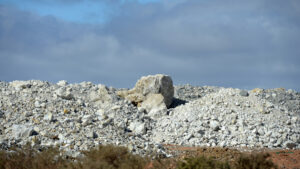Trinex locates widespread lithium mineralisation at Halo-Yuri

Trinex says results to date have exceeded expectations at the Halo-Yuri lithium project. Pic: Getty Images
- Assay results from the first two batches of pegmatite outcrops have confirmed lithium mineralisation
- This confirms the potential that Halo-Yuri could host a significant lithium resource
- Trinex is now preparing a Land Use Permit application
Special report: The first phase of field work at Trinex’s Halo-Yuri project in Canada has identified multiple areas with high-grade lithium in spodumene bearing pegmatite outcrops and boulders, with the highest assay returning 5.1% Li2O.
Trinex Minerals (ASX:TX3) acquired three projects in late 2023 in Canada’s Northwest Territories with the 450km2 Halo-Yuri asset representing both the largest and northernmost of the three projects.
While historical exploration focused on finding diamonds with little or no work on its spodumene-bearing pegmatites – documented but essentially untouched – recent satellite imagery has identified hundreds of pegmatites that require follow-up.
Trinex is now undertaking the first phase of field work to determine whether there were any spodumene occurrences worthy of further work.
Multiple areas with high-grade lithium in pegmatite outcrops
Assay results received so far from this program have demonstrated that multiple areas contain the presence of high-grade lithium in spodumene-bearing pegmatite outcrops and/or boulders.
The company says these structures present immediate walk-up drill targets.
Around 94 of the 96 samples were described as “spodumene bearing” with significant lithium assay values including 5.1% Li2O – the average assay being 1.6% Li2O.
The remaining batch of assay results, which includes 25 additional mineralised samples and around 50 un-mineralised pegmatite and granite samples, is expected in around two weeks.
Robust targets in emerging lithium province
“This is an outstanding result for Trinex and we are delighted that the hard work the team has put in on the Canadian projects is starting to pay off,” TX3 managing director Will Dix says.
“We have a number of robust targets that have the potential to be world class discoveries in an emerging lithium province and this absolutely vindicates our decision to acquire these properties.
“Our work will now turn to planning follow up work and submitting a land use permit application as well as ongoing engagement with the indigenous communities in the area.”
With James Bay already packed tight with TSX-V and ASX hopefuls hoping to replicate PMT’s success, explorers have been looking further afield.
Canaccord Genuity head of research Reg Spencer, for instance, highlighted the Northwest Territories last year as an emerging exploration domain in Canada popping up on investors’ radars.
Centred around the city of Yellowknife, exploration is picking up in a region historically known as a gold and diamond mining district. Everyone knew the lithium was there but, until recently, no none cared, something which has changed as explorers have made significant discoveries.
What’s coming up?
TX3’s next step at Halo-Yuri is to lodge a Land Use Permit Application to enable a drilling program to be completed.
It is not certain at this stage when a drilling program will be completed as further engagement with local stakeholders and additional sampling and trenching is required in some areas.
Having the Land Use Permit approved gives the company certainty that this work will be able to be completed.
This article was developed in collaboration with Trinex Minerals, a Stockhead advertiser at the time of publishing.
This article does not constitute financial product advice. You should consider obtaining independent advice before making any financial decisions.
Related Topics

UNLOCK INSIGHTS
Discover the untold stories of emerging ASX stocks.
Daily news and expert analysis, it's free to subscribe.
By proceeding, you confirm you understand that we handle personal information in accordance with our Privacy Policy.








